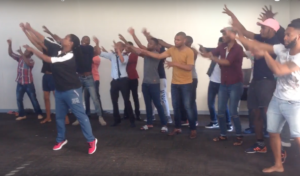Month: September 2016
Ukwakha Opening and more footage
Back in Liverpool and the first week flew by with a lot of work to catch up with, and I still have to sort out more footage from Cape Town, but here’s already the opening part of Indoni’s Ukwakha @ Magent Theatre – not the greatest of recordings there with limited technology but it will give you a good idea – hope you’ll enjoy watching and feel free to leave a comment below 🙂
Ukwakha Opening
P.S.: I loved the way the audience expressed their emotions during the show – why can’t we all just let it out like that? 😀
P.P.S.: One of my favourite stills, more to come soon:
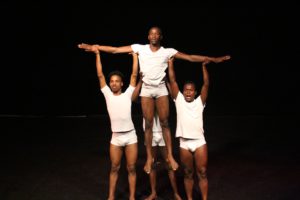
P.P.P.S.: If you missed the previous blogs about my stay in South Africa – here’s a YouTube playlist with all the footage I’ve uploaded so far:
Artist International Development Fund 2016 – Video Footage
– or feel free to have a look through the archived blogs on the right.
Composing for Indoni
The main objective of my stay in South Africa of course was to contribute original music to Indoni’s show Ukwakha (“We build”), so after spending a week observing rehearsals, taking video footage and exchanging creative ideas with Sbo, the Artistic Director and choreographer, I retreated to a quiet place in nature on the edge of civilisation on the Southern tip of the KwaZulu Natal South Coast to compose, arrange and produce music that would fit the requirements.
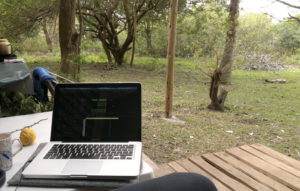
For the opening sequence Sbo wanted an epic sounding orchestral track so I installed an extensive orchestral sound library on my MacBook Pro with the help of my dear friend Ian Finney, and got my head around using sample tank and programming articulations, thanks to his never ending good advice.
With so much choice for instruments and dozens of available articulations it took a considerable amount of time to decide what to use in the first place and then get it sounding right, and I could have spent another four weeks refining it if I would have had the time.
Another challenge on top of that was the general structure of the piece, with several time signature and tempo changes.
But the most daring aspect was probably the energy levels that were required to carry an athletic and intense performance by a company of 19 dancers.

Adding a live djembe track (luckily I happened to find a tuned djembe in my host’s lounge in KZN) seemed to do the trick – even before I had my first official lesson 🙂
All in all it was a steep learning curve but after a few weeks of hard work I am happy to say that Sbo really liked what I created.
Another part of the choreography was an intimate, emotional duet for which I composed a solo piano piece, and again, it did match the sequence well and I am proud to say that both pieces are included the show now as planned.
I had many more ideas for other parts of the show and even started with some new tracks, including a more meditative piece with natural ambiences I recorded in KwaZulu Natal – but within the given time frame it was simply not possible to develop and finalise anything else.
Last night the show finally opened at Magnet Theatre in Cape Town and the dancers once again amazed me with their sheer energy and stage presence. They are truly the most hard working young adults I’ve ever met, their professional attitude and discipline is outstanding.
The show will be on again tonight followed by two performances on Saturday. Watch this space for video footage soon – if technology doesn’t let me down again like last night… :/
Both Sbo and I are very happy with the outcomes of this collaboration, and feel that this is just the beginning of a long lasting creative relationship, with lots of exciting ideas for the future.
Thank you Sbo and Indoni for giving me this amazing opportunity, I really hope to be working together again soon!
My biggest thanks goes to Arts Council England and British Council who funded this adventure through the Artist International Development Fund.

Drums and Kalimbas with Juma Drums
When I first visited in March, Indoni were rehearsing in a fairly run down community hall in Gugulethu, with a leaking roof and holes in the floor, so I was delighted to hear a few months ago that they found a better space at Oude Molen Eco Village. I was even more delighted when I learned more about the Eco Village, which was originally initiated as a micro enterprise village in 1997 by a small group of social entrepreneur tenants with the initial aim to optimise the use of an abandoned and vandalised hospital complex in order to address socio-economic challenges such as job creation, youth development and food security in the region by utilising micro-enterprises, non-profit organisations and social enterprise services.
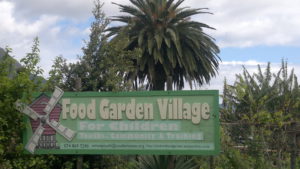
Over the past seventeen years the village has evolved into a diverse community consisting of numerous metal, wood and craft enterprises, social projects, food gardens, a public swimming pool and recreation facilities, a frail care center, a farm stall café, horse-riding activities, backpacker accommodation, artists, musicians and film industry services.
On my first arrival I straight away fell in love with this place, you feel like you’re in the country side with the smell of mulch, straw and horses, chicken running around, a farm stall cafe, a Waldorf school and lots of interesting businesses, including Juma Drums, where I was heading for last Friday.
Dingiswayo Juma is a multi-skilled multi-instrumentalist, drummer, percussionist and instrument maker and he started the first lesson by teaching me the proper technique for playing the djembe.
He also does repairs and re-skinning so all his drums are beautifully tuned up and a great joy to play. Later that day I learned a rhythm from Ghana called Nagla, with calls and answers and even some words and melody that goes with it. I managed to pick up the rhythms and melodies but the words I admittedly just mumbled along – a lot to process for my European brain and body 🙂
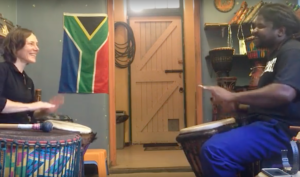
Quickly adapting to my skill levels and finding the right kind of challenges that left me with a sense of achievement proves his ability and experience as a teacher, I cannot recommend him highly enough.
A few days later I went back for more and we recorded a Djembe ‘jam’ together with the view of possibly using it in the show. It was great to play and improvise together freely after recapping on techniques and a short warm up.
Dingiswayo has got a whole selection of fascinating African instruments so I arranged for a third meeting to find out more about the Kalimbas and Mbiras, which he makes himself from scratch, using local wood and metal rods which he hammers into the tongues, all perfectly tuned up with the help of an electronic tuner. Most interesting I found the use of the calabash, a large gourd which is cut to make a semi-sphere and in which the Kalimba is placed to act as an acoustic body and thereby amplifying the sound. The Mbira is a larger version of the Kalimba, which sounds lower and has more metal tongues and a more difficult technique, starting with holding it the right way and using the right index finger in addition to the thumbs.
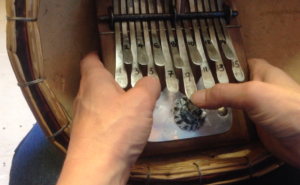
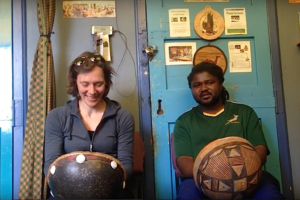
I learned some basic patterns and chords and felt like I was just getting the hang of it when the lesson was over already. Time flies if you’re enjoying yourself 🙂
Visiting the Creative Arts Choir
I was invited to attend a rehearsal of the Creative Arts Choir at the University of the Western Cape in Belleville and I was blown away by the sheer beauty of their voices, their energy, dynamics and high standard. It was very educational for me to watch the talented MD Sibusiso Njeza in action. Sibusiso is also an acclaimed composer, having written two operas, namely Madiba the African Opera based on the life and time of the great Nelson Mandela and Blood of Mine based on a story set in a small town in Botswana.
Needless to say that I was very impressed by his musicality, professional leadership skills and calm authority.
The first song I heard was a wonderful arrangement of “Stand by me”, one of the first songs we learned with our Choir With No Name in Liverpool – our version is comparably simple so this was hugely inspiring for me as a choir director and arranger. I was moved close to tears, as so often when I hear African voices united.
Sbonakaliso Ndaba was asked to teach the choir some movements and it was fascinating to watch some traditional South African moves being incorporated into the vocal performance, not just a bit of swinging left and right and a few handclaps, but quite elaborate movement sequences, including exciting highlights such as choreographed stick fights.
After the rehearsal I had a chance to meet and have a quick chat with Lebohang Mbuthuma, the chair woman of the choir, and she explained to me a bit more about the choir’s background and I learned that the Creative Arts Choir’s objectives are very similar to the ones of our Choir With No Name in UK, being an open choir with no auditions, with an emphasis on confidence building and socialising, and encouraging drop outs to rejoin academic life.
This choir is mainly funded by prize money from competitions in which they (rather successfully) take part on a regular basis, and I am sure with the added visual bonuses of exciting movements this choir will go very far.
Thanks for having me!
